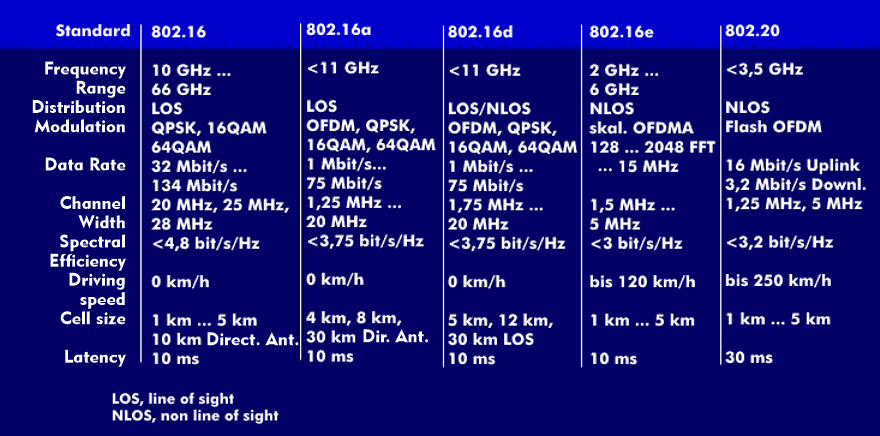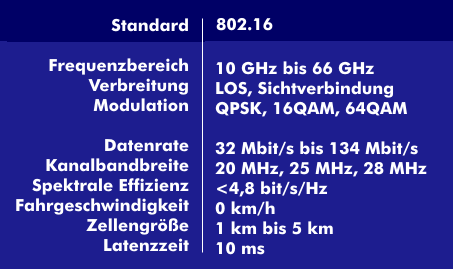IEEE 802.16
The IEEE802.16 working group is concerned with wireless access technologies for broadband networks, specifically with an air interface, i.e., an Air Interface for Fixed Broadband Wireless Access Systems. The IEEE 802.16 specifications are concerned with data rates of more than 100 Mbit/s over distances of more than 50 km.
The frequency range used for transmission is between 10 GHz and 66 GHz and is defined as line-of-sight( LOS). The frequency ranges used in Germany are 23 GHz and 38 GHz. Since a direct line-of-sight link is generally not available in urban areas, there is a second specification, 802.16a, for the frequency range between 2 GHz and 11 GHz for poor line-of-sight conditions.
The 802.16 standardization bodies are equally concerned with the media access method( MAC) and the physical layer( PHY), assuming broadband transmission links with bandwidths of 20 MHz, 25 MHz and 28 MHz for the uplink and downlinkchannels. As a media access method, which must be adapted to the different environments of the physical layer, 802.16 uses TDMA with Time Division Duplex( TDD) or Frequency Division Duplex( FDD). The maximum data rate specified is 134 Mbit/s for a 28 MHz channel. In addition, 802.16 defines a guaranteed quality of service( QoS) in four classes of service that support the time-critical transmission of audio and video files.
This working group, called Broadband Wireless Access( BWA), works very closely with the 802.11 working group. The results are being incorporated into WiMAX.
The different 802.16 standards
802.16a: Licensed Frequency 2 GHz to 11 GHz. The IEEE 802.16a working group is working on the MAC and PHY specifications and specifies transmission innon-line-of-sight ( NLOS) links. Important frequencies are 3.5 GHz for license-required and 5.8 GHz for license-free applications. The data rate is 75 Mbit/s with a channel width of 20 MHz. 802.16a is superseded by 802.16-2004
802.16b: Licensed Exempt Frequencies, focusing on the frequency band between 5 GHz and 6 GHz. This group is also known as WirelessHUMAN (High Speed Unlicensed MAN).
802.16c:Profiles the transmission frequencies in the frequency range from 10 GHz to 66 GHz. The channel width is 25 MHz in the USA and 28 MHz in Europe. 802.16c is superseded by 802.16-2004
802.16d: Profiles the transmission frequencies in the frequency range from 2 GHz to 66 GHz. Superseded by 802.16-2004, this standard provides line-of-sight and non-line-of-sight links in the 2 GHz to 66 GHz range.
802.16e-2005: Mobile Wireless MAN(WMAN). This working group defines mobile access in the context of IEEE 802.16. Bandwidths of more than 10 Mbit/s are investigated here with radio cells in the range of several kilometers and speeds of over 100 km/h. In addition, 16e clients should be able to switch between different radio cells, known as roaming. 802.16e in conjunction with Dedicated Short Range Communication( DSRC) is an interesting alternative for telematics and safety-related services in automotive technology.
802.16f: MIB management for access networks.
802.16g: Definition of management plan.
802.16h: Coexistence of Networks and Licensed Exempt Coexistence. This working group deals with the coexistence problems of different radio technologies in different license-exempt transmission bands. Since, in addition to 802.16, 80.11a also uses the UNII band at 5 GHz, for example, coexistence problems have to be solved here
802.16i: Mobile Man Information Plane. The standard has been withdrawn.
802.16j:Bridging alternative to802.11k. This involves techniques for a mobile relay, Mobile Multi-Hop Relay, which can connect communication partners via several stations.
802.16k: Bridging
802.16m: The 802.16m working group is working on high-speed transmission at up to 1 Gbps and defines an Advanced Air Interface for gigabit transmissions.
802.16n: FAN network reliability and robustness.
802.16p: Machine-to-machine enhancements, M2M.
802.16-1: Air interface for 10 GHz to 66 GHz.
80216.2: Coexistence of Broadband Wireless Access Systems. This working group deals with the coexistence of existing systems. Superseded by 802.16.2-2004.
802.162-2004: Combines 802.16, 802.16a, 802.16c, and 802.16d into one standard and governs the coexistence of broadband wireless systems in the 10 GHz to 66 GHz range.
802.16.2a: Recommended Practice for Coexistence of Fixed Broadband Wireless Access Systems. This group is intended to redefine the coexistence of PMP systems between 2 GHz and 11 GHz.
802.16.3: Air Interface for Fixed Broadband Wireless Access Systems Operating below 11 GHz. This working group will investigate the unlicensed frequency bands such as the ISM band, Personal Communication Services( PCS), Multichannel Multipoint Distribution System( MMDS), and Unlicensed National Information Infrastructure (UNII) for use for high-speed MAN access.


